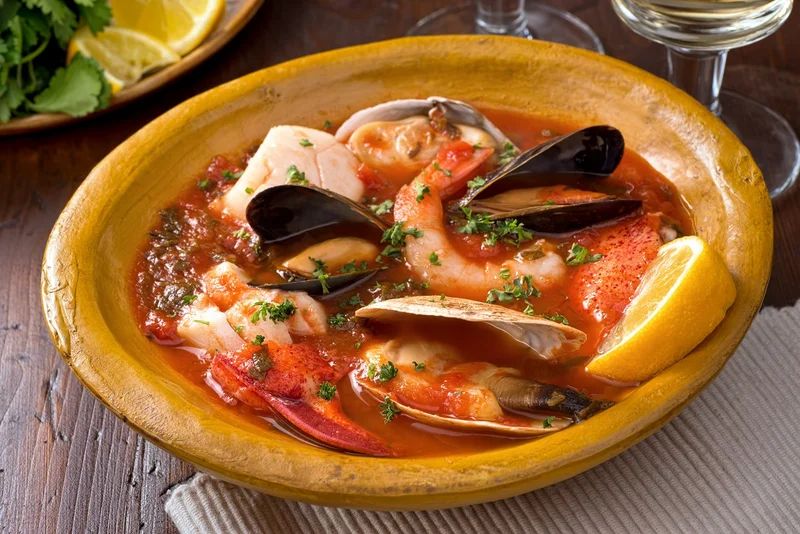Cioppino is an Italian-American seafood stew that originated in San Francisco in the 1930s, when fishermen brought their fresh catch to the docks and a little bit of everything was added to the soup pot the workers shared—which is one urban-legend explanation for the name; some sources claim “cioppino” was Italian-American slang for “chip in”. In reality, it derives from a Ligurian soup called ciuppin, which literally means chopped. The base of the stew is a wonderfully garlicky tomato broth with white wine and herbs, but the type of seafood you use is endlessly adaptable, so don’t feel constrained by this specific recipe (which was inspired, in part, by two of our Chowhound users, nstrada and giod).
Variations: The whole point is to use whatever’s freshest, and whatever you like best, so add crab or lobster, or double up on the shrimp and cut out the mussels, even try adding salmon in place of the firm white fish, or a little sliced calamari at the very end of cooking; just shoot for about 5 pounds of seafood in total. Some people like to sauté a little chopped celery and carrot along with the onion, and even a bit of bell pepper for additional sweetness, but we’ve gone light on the vegetables in general to really highlight the seafood. Feel free to add more to your mirepoix if you prefer.
Serve with: Garlic bread or toasted sourdough—perfect for mopping up all the rich, sweet, garlicky tomato broth left in the bowl.
Make ahead: You can make the broth a day or so ahead and refrigerate it, which can help to meld the flavors, then bring it back to a gentle simmer and cook the seafood in it just prior to serving.
For more true San Francisco treats, get Mission Chinese Food’s Chicken Wings with Explosive Chile recipe, and The Slanted Door’s Vietnamese Shaking Beef recipe.
- Yield: 6 servings
- Difficulty: Medium
- Total: 1 hr 30 min
- 1 28-ounce can whole San Marzano plum tomatoes in juice (you can also use an equal amount of stewed tomatoes, crushed tomatoes, or diced tomatoes in juice)
- 2 cups fish stock or bottled clam juice
- 5 tablespoons olive oil
- 1 large yellow onion, chopped
- 5 cloves garlic, minced
- 2 tablespoons tomato paste
- 1 teaspoon dried oregano
- 2 sprigs fresh thyme
- 2 bay leaves
- 1 teaspoon crushed red pepper flakes
- 1 1/2 cups dry white wine
- 1 pound uncooked large shrimp, peeled and deveined
- 1 pound Manila or littleneck clams in the shell, scrubbed
- 1 pound mussels in the shell, scrubbed and debearded
- 3/4 pound large sea scallops, tough adductor muscles trimmed from sides if necessary
- 1 1/2 pounds firm white fish like halibut, snapper, cod, or sea bass (or a mixture thereof), skinned, deboned, and cut into 2-inch chunks
- 3 tablespoons fresh basil, chopped (optional)
- 1/4 cup fresh flat leaf Italian parsley, chopped
- kosher salt, to taste
- freshly ground black pepper, to taste
- Heat a large, heavy-bottomed pot over medium-high heat, then add the olive oil and allow to heat for another 30 seconds or so until hot but not smoking. Add the onions and a pinch of salt and sauté for about 5 minutes, or until onions are soft and translucent. Add the garlic and sauté, stirring, for another minute. Do not let garlic brown.
- Stir in the tomato paste and sauté for another minute, stirring all the while. Stir in the oregano, thyme, bay leaves, and crushed red pepper, then add the white wine and stir to combine. Allow to simmer until the wine is reduced by half, about four minutes. Add the tomatoes and their juice, along with the fish stock or clam juice, and stir to combine. If using whole or crushed tomatoes, use a wooden spoon to break them up into smaller pieces. Bring the liquid back to a simmer and cook for about 30 minutes, but do not allow to boil.
- When the flavors of the broth have come together, add the clams and mussels to the pot and cover; cook for about 5 minutes, then add the shrimp, scallops, and fish, and gently simmer for another 5 minutes, or until the seafood is just cooked through.
- Discard any clams and mussels that have not opened. Taste the broth and season with salt and pepper as needed. Discard the bay leaves and thyme sprigs and stir in the fresh basil if using, then serve the soup immediately, dividing the different types of seafood evenly among the bowls and garnishing each with parsley.


